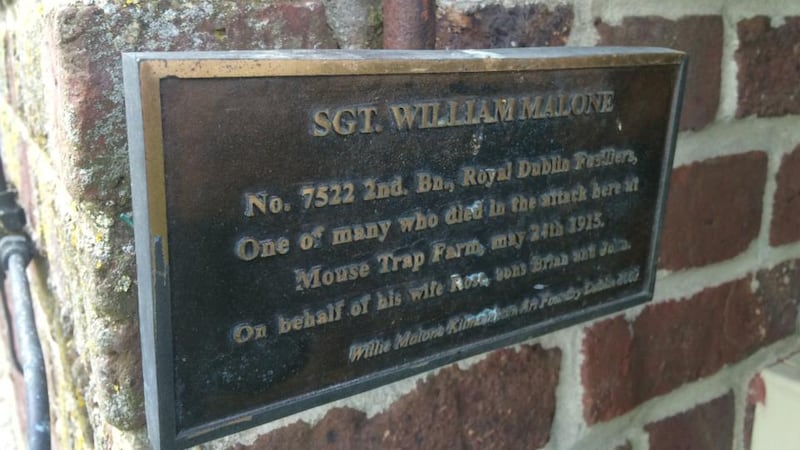In late spring 1915, Dublin was a city in mourning. The first World War, not yet nine months old, brought devastation on a scale never seen before or since to the streets of the city.
In the space of a single month from April 24th, 1915, to May 24th, 1915, more than 1,000 men from Dublin were slaughtered and this from a city less than half the size it is today. The regular service 1st and 2nd battalions of the Royal Dublin Fusiliers, drawn mainly from working-class communities where soldiering was one of the few viable professions, were effectively wiped out on separate fronts.
The 1st battalion was part of the disastrous landings at V Beach in Gallipoli on April 25th, 1915. In just 15 mad minutes the battalion suffered nearly 600 casualties as it tried to row ashore under heavy Turkish machine gun and artillery fire.

Less well known, but even more devastating, is the fate of its sister battalion, the 2nd, during the Second Battle of Ypres which coincided with the landings at Gallipoli.
On April 22nd, 1915, the Germans released chlorine gas into the Allied lines surrounding Ypres. The use of poison gas was prohibited under the terms of the Hague convention. This was a new and beastly turn.
On April 25th, 1915, the 2nd battalion force marched 50 kilometres to fill a gap in the British lines to try and retake the village of St Julien from the Germans. They got within 100 yards of the German lines before being “mown down, like corn, by machine guns in enfilade. They remained lying dead in rows where they had fallen”, as the British official history put it.
The battalion suffered 500 casualties, similar to what 1st battalion suffered in Gallipoli.
Worse was to follow a month later at a place called Mouse Trap Farm which exists to this day. Mouse Trap Farm was a place of dread for the British soldiers, who nicknamed it Shell Trap Farm.
The assault on Mouse Trap Farm was to be the Germans’ last attempt to take Ypres from the British. On the morning of May 24th, 1915, they drenched the Allied lines with chlorine gas along a 12 kilometre front.
Three Irish battalions held the line around Mouse Trap Farm. To the right was the 1st Royal Irish Fusiliers, in the centre was the 2nd Royal Dublin Fusiliers and to the left was the 2nd Royal Irish Regiment.
The RDF bore the brunt of the German assault on the trenches surrounding Mouse Trap Farm. Their trenches were within 35 metres of the German lines. They could hear the hissing of the gas being released. Within seconds the Germans were on top of them.
The assault began before first light and continued until midday.
The Dublins quickly lost their commanding officer, Lieut Col Arthur Loveband, from Naas, Co Kildare, who was shot through the heart. The situation for the RDF grew ever more desperate. One officer sent out the message “For God’s sake send some help, we are nearly done”. No help was forthcoming. The only surviving officer, Capt Leahy, recalled that the men “died fighting at their post”.
At the end of the day all that was left was one officer and 21 other ranks out of a total complement of 658 officers and men. Rarely in that terrible war had a single battalion suffered such a wipeout.
The Royal Irish Regiment, drawn mostly from the southeast and the Royal Irish Fusiliers from Armagh, Cavan and Monaghan, also suffered grievous losses in what was the bleakest of bleak days for Irish regiments. The whole of Ireland was affected by the tragedy, which also claimed the life of Pte John Condon from Waterford city who was with the Royal Irish Regiment. At 14, he was the youngest Allied soldier to die in the war. He too will be remembered this weekend.
Mouse Trap Farm was rebuilt after the war. It is now mainly a pig farm. From its long laneway you can see the twin spires of the Cloth Hall and the cathedral at Ypres. It was so near and yet so far for the Germans. Ypres became the British Verdun. It would not be taken at any cost even if that cost turned out to be nearly 200,000 British and Irish lives.
On the gable wall of the farm are two plaques. One, recently put there, remembers Pte William Byrne (19) from Blackrock, Co Dublin, who died on May 24th. The other is a bronze plaque to Sgt William Malone (36) from the South Circular Road. It was put there 10 years ago by his grandson, a bronze sculptor also called William Malone.
Sgt Malone was a brother of Lieut Michael Malone, the republican hero of Mount Street Bridge. During Easter Week 1916 he inflicted terrible casualties on the Sherwood Foresters from a house in Northumberland Road before being killed.
In less than a year two brothers from the same family died; one fighting for the British, another fighting against them – the complications and contradictions of Irish history laid bare in a single grieving family.
The Royal Dublin Fusiliers Association has arranged a Mass in Saint Nicholas of Myra, Francis Street, Dublin, at 6pm on Saturday to remember all those who died at Mouse Trap Farm.









